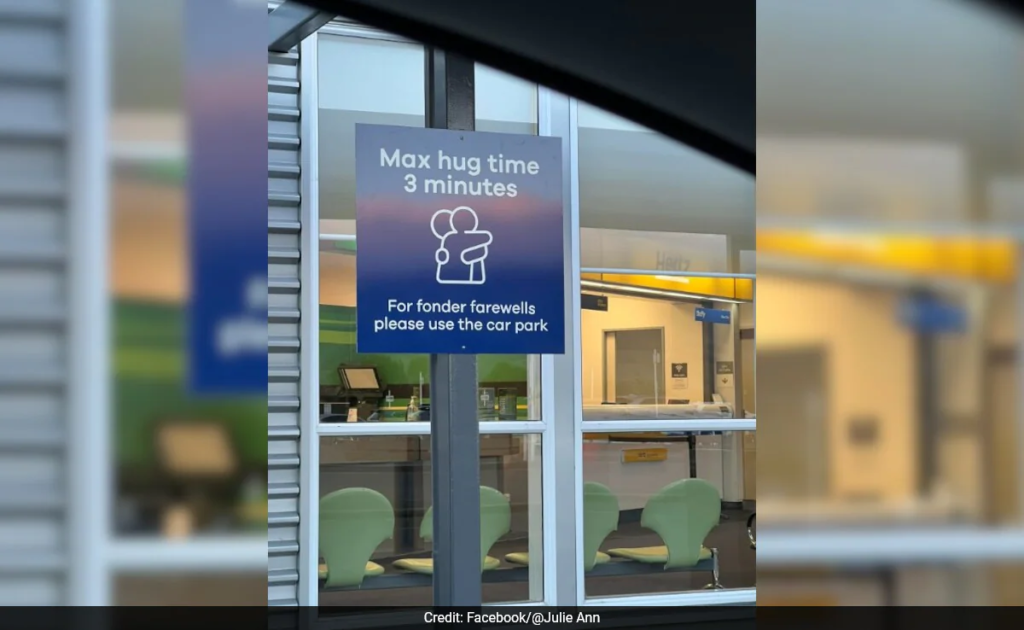New Zealand’s Dunedin Airport has recently implemented a new policy that restricts the time people have to say their goodbyes at the airport’s drop-off zone. The new rule, which limits farewells to just three minutes, has sparked a lively debate among passengers and the public.
While some see it as a necessary move to improve airport operations, others find the restriction excessive and even inhumane. The move has brought attention to the emotional dynamics that unfold at airports and raised questions about how to balance efficiency with human emotions.
Emotional Farewells at Airports: Why Hugs Matter
Airports are more than just places for planes to take off and land; they are emotional hotspots where people experience both the joy of reunions and the sadness of goodbyes.
Dunedin Airport CEO Daniel De Bono acknowledged this in a recent interview, citing the emotional nature of airport farewells. He even referenced a study showing that a 20-second hug can release oxytocin, known as the “love hormone,” which helps people feel connected and less stressed.
Read : Big Fan of India, A Country I Admire Tremendously: New Zealand PM Luxon
However, the airport’s new policy aims to limit these emotional farewells, restricting passengers and their loved ones to just three minutes in the drop-off zone. For many, this short window of time seems insufficient to say a meaningful goodbye, especially when emotions are running high.
A viral post on social media highlighted the mixed reactions to the policy, with some users expressing outrage over the limitation on hugs, while others praised the practicality of the move.
Read : Kiwi Wonders: Exploring New Zealand’s Top Natural Attractions
The debate reflects a broader issue: how much time is enough to say goodbye? For some, three minutes might be enough, especially in a world that often prioritizes efficiency over emotion. But for others, it feels rushed, as if the airport is trying to push people through a conveyor belt of farewells.
The emotional toll of this new rule is especially felt by families and couples who are saying goodbye for long periods of time, and for whom a hug might be more than just a formality—it could be the last physical connection for months or even years.
Practicality Meets Emotion: The Logic Behind the 3-Minute Rule
While the emotional aspect of farewells cannot be ignored, the airport’s decision is rooted in practical concerns. According to De Bono, the new policy was introduced to improve traffic flow and enhance safety around the terminal. By limiting the time spent in the drop-off zone, the airport hopes to reduce congestion and allow more passengers to be dropped off safely and efficiently.
In his interview with New Zealand’s RNZ radio, De Bono explained that relocating the drop-off zone has made it closer to the terminal entrance, averaging 74 metres nearer than the previous location.
This was done not only to ease traffic but also to accommodate passengers who need quick access to the terminal. The drop-off area now features a covered walkway, protecting passengers from the elements as they make their way inside.

From a logistical standpoint, the three-minute rule makes sense. Dunedin Airport are busy places, and long goodbyes can cause traffic jams, potentially delaying other passengers who are trying to catch their flights. Additionally, ensuring the safety of passengers and drivers is a top priority, and managing the flow of vehicles in the drop-off area is one way to achieve that.
However, some argue that the policy fails to take into account the human need for connection and closure during farewells. While the airport offers 15 minutes of free parking for those who need more time, critics say that it’s not always feasible for people to park and walk back to the terminal just to extend their goodbyes.
For those who are dropping off elderly or disabled passengers, the three-minute rule may also feel like an unreasonable limitation.
Public Reaction: A Divisive Issue
The public reaction to Dunedin Airport’s new policy has been polarizing. On social media, many people expressed outrage, calling the rule “inhumane” and “unnecessary.” One viral Facebook post attracted numerous comments from users who felt that restricting hugs and farewells was an overreach by the airport.
Some even suggested that the policy made farewells feel cold and impersonal, as if the airport was prioritizing efficiency over human connection.
On the other hand, some people supported the new rule, arguing that it was a practical solution to a common problem. They pointed out that many airports around the world have introduced similar measures to manage congestion and improve safety.
For these users, the idea of limiting time in the drop-off zone was not only reasonable but necessary, especially in light of the increasing number of passengers traveling through Dunedin Airport.

Others took a more humorous approach to the situation, suggesting that if three minutes wasn’t enough time for a proper hug, perhaps it was time to re-evaluate how farewells are handled. Some even recommended that the policy be adopted by other airports, noting that the growing charges and penalties at many airports make the free drop-off zone at Dunedin a rare and valuable service.
De Bono, for his part, remained diplomatic in his response to the criticism. He acknowledged that airports are emotional places and that farewells are often difficult, but he maintained that the new policy was necessary to ensure the smooth operation of the airport.
He also pointed out that the airport had seen “interesting things” in the car park over the years, hinting at the variety of emotional and sometimes chaotic scenes that unfold as people say their goodbyes.
Balancing Efficiency and Emotion: Is There a Middle Ground?
The controversy surrounding Dunedin Airport’s three-minute rule raises important questions about the balance between efficiency and emotion in public spaces.
On one hand, the airport has a responsibility to ensure that operations run smoothly and that passengers can be dropped off safely and on time. Congestion in the drop-off area can lead to delays and safety concerns, both for passengers and for airport staff.
On the other hand, Dunedin Airport are unique in that they are often the setting for deeply emotional moments. Saying goodbye to a loved one before a long trip or welcoming them back after an extended absence is an important ritual for many people. Limiting the time people have to say these goodbyes can feel like an intrusion on a personal, emotional experience.

The solution may lie in finding a middle ground. While the three-minute rule is aimed at improving efficiency, perhaps the airport could consider offering a designated “farewell zone” where people can take their time saying goodbye without disrupting traffic.
This could be a space separate from the drop-off zone, where people can park and spend a few extra minutes together before parting ways.
Alternatively, the airport could extend the free parking time in the car park, giving people more flexibility to say their goodbyes without feeling rushed. By offering options that accommodate both practical needs and emotional ones, the airport could address the concerns of both sides of the debate.
Dunedin Airport’s decision to limit hugs and goodbyes to three minutes in the drop-off zone has sparked a debate about the role of emotions in public spaces. While the policy aims to improve traffic flow and safety, it has also highlighted the importance of farewells in the lives of passengers and their loved ones.
As Dunedin Airport continue to evolve and adapt to the growing demands of modern travel, finding ways to balance efficiency with the human need for connection will be an ongoing challenge.
let’s enjoy few years on earth with peace and happiness….✍🏼🙏

